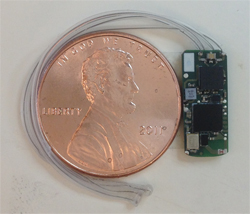Neuroscience: Where engineering meets biology
Neuroscience: Where Engineering meets Biology
PIIN functions as a hub for the 130 Purdue faculty involved in neuroscience research. “The institute brings us all together into a cohesive whole,” says Pedro Irazoqui, associate head and professor of biomedical engineering. “It allows us to understand the ecosystem.
“It is a key effort to bring together groups of faculty to undertake high-impact research — but who initially didn't even know about each other,” adds Irazoqui, whose work involves creating devices to improve brain health. “We can address problems where you can bring engineering skills into play from one side and the neuroscience expertise from another.”
The institute opened its virtual doors in 2015. Donna Fekete, who holds the John and Donna Krenicki Directorship of Integrative Neuroscience, was instrumental in pitching the need for an integrated neuroscience center at Purdue. As a biologist, Fekete studies how inner ear cells send signals to the brain. As the institute director, her job is to make sure there is a tangible home for neuroscience researchers at Purdue.
“In these initial years," she says, "I’ve been working toward creating a sense of community among the neuroscientists at Purdue by providing new core facilities that will service the whole community of neuroscientists here in a way that we did not have before.”
Photo (right): At the Purdue Center for Implantable Devices, engineers develop tools that both record and stimulate the nervous system in rodents. (Photo credit: Marti LaChance)
Behavior studies core
 Understanding small animal behavior is vital to neuroscience, so it is natural for PIIN and the Weldon School to partner in creating a behavior core. Irazoqui adds, “By leveraging Purdue’s excellence in engineering, our core will introduce a continuously evolving set of unique engineering tools enabling a whole range of neuroscience experiments that will only be possible at Purdue.”
Understanding small animal behavior is vital to neuroscience, so it is natural for PIIN and the Weldon School to partner in creating a behavior core. Irazoqui adds, “By leveraging Purdue’s excellence in engineering, our core will introduce a continuously evolving set of unique engineering tools enabling a whole range of neuroscience experiments that will only be possible at Purdue.”
The new Innovation Wing core will be housed in the new expansion of the Martin Jischke Hall of Biomedical Engineering. The facility will enable Purdue neuroscience researchers to use standardized gear for animal behavior research, things like rolling rods for balance tests, a tank for swimming tests, and equipment for doing long-term monitoring of social behavior. The facility will also allow for optigenetics work, an important new light-based technique for studying the brain.
In this facility, engineers in the Weldon School will be able to do wireless device recordings and stimulations of the nervous system in awake, behaving animals. “Combining the engineers’ expertise in wireless devices with the biologists’ more standard assays of animal behavior is a natural fit,” Fekete says, “and it bring life sciences and engineering together.”
Caption (right): In the Center for Implantable Devices, led by Professor Pedro Irazoqui, engineers have created a microcomputer that acts as an intuitive link between the brain and a prosthetic limb, and allows for full control of a robotic arm.
Traumatic brain injury
 Another core area of collaboration between PIIN and the Weldon School is traumatic brain injury. In 2015, the College of Engineering funded the Healthy Brain preeminent team, which resulted in hiring engineering faculty with expertise in traumatic brain and spinal cord injuries. “That is another area of strength at Purdue where we see our neurosciences partnering with the engineers to make advances,” Fekete says.
Another core area of collaboration between PIIN and the Weldon School is traumatic brain injury. In 2015, the College of Engineering funded the Healthy Brain preeminent team, which resulted in hiring engineering faculty with expertise in traumatic brain and spinal cord injuries. “That is another area of strength at Purdue where we see our neurosciences partnering with the engineers to make advances,” Fekete says.
The College of Engineering now boasts several engineering researchers who specialize in imaging the brain, from the cellular to the whole-brain level. The team is led by Thomas Talavage, professor of electrical and computer engineering and biomedical engineering. He is also a founding co-director of the Purdue MRI Facility, where medical imaging technologies are being used to quantify injuries to the brain. Biomedical engineers also are interested in modifying imaging technology to be even more powerful and instructive for patient diagnoses.
Photo (right): Researchers in the Systems Neuroscience of Auditory Perception lab (SNAPlab) study biological computations and neural circuits that underlie auditory perception. The lab is part of the Weldon School of Biomedical Engineering and the Department of Speech, Language and Hearing Sciences. The SNAPlab is led by Professor Hari Bharadwaj, who has a joint appointment in the Weldon School and SLHS.
Collaborative hiring. Joint hiring efforts are an illustration of the close and natural integration between the Weldon School and PIIN. This year they are looking to hire two new faculty this way.
But such collaborations should not be so surprising. The neuroscience underway at Purdue is highly interdisciplinary. About two-thirds of the institute’s members have expertise in areas outside of neuroscience but possess a tool set that can be applied to brain research — researchers like the Weldon School engineers. As Fekete says, “That’s what makes the field so rich, right?”
